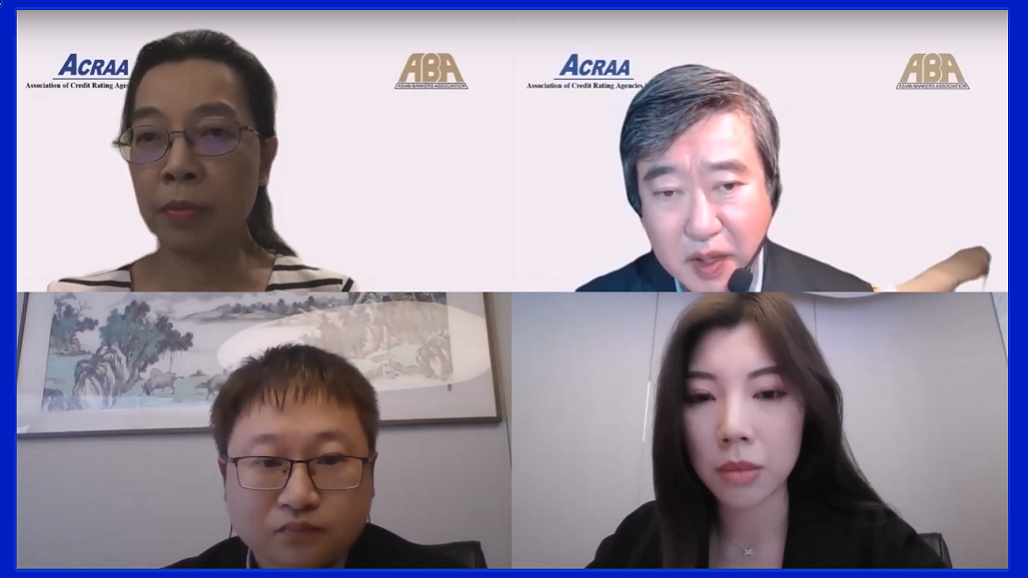 The Asian Bankers Association (ABA) and the Association of Credit Rating Agencies in Asia (ACRAA) successfully held the webinar “A storm ahead? An updated view on the Asian economy” on 13 October, 2022.
The Asian Bankers Association (ABA) and the Association of Credit Rating Agencies in Asia (ACRAA) successfully held the webinar “A storm ahead? An updated view on the Asian economy” on 13 October, 2022.
The ninety-hour session gathered more than 431 registered participants from all over Asia and featured three experts: Atsushi Masuda, ACRAA Chairman & Counselor for International Affairs, Japan Credit Rating Agency Ltd. (JCR) and Lina Wang, Senior Analyst of Sovereign Rating, China Chengxin International Credit Rating Co. (CCXI), with Lin Zhang, Assistant Director of Research Institute, CCXI who joined the extended Q&A session.
We are pleased to present here the summary of the presentations, the presentations, and the video recording of the webinar.
SUMMARIES
(1) Four questions on the possible scenario for the global economy, presented by Atsushi Masuda
- At this moment, inflation pressure is growing beyond “temporary” but still it is projected to stabilize once geo-political factor and outright USD appreciation will be corrected.
- Inflationary pressures are mounting and US FED responded by unprecedented pace of interest rate hike.
- Inflationary pressures are amplified in the emerging markets.
- It may be safe to think the Great Moderation ends really this time in view of revived inflation and higher volatilities.
- Fear of recession has been also surfacing in view of concerted monetary tightening world wide, but the argument of similarity to 2007 is not valid at this moment.
- The sectors which had been damaged by COVID19 shock will be affected by forthcoming downturn of business cycle.
(2) The recovery of China’s economy – Steering through turbulent waters, presented by Lina Wang
The speech focuses on the recovery of China’s economy amid multiple external and internal challenges. First, the speech went through the fundamentals and outlook of China’s macroeconomy with key economic components and supporting data. GDP in Q2 recorded a weak growth of 0.4% with recurrent COVID-19 outbreaks.
The contribution of service industry and consumption to GDP growth hit the lowest level. Industrial sector is more resilient, while the service industry recovers slowly. The growth rate of industrial added value rose from -2.9% in April to 4.2% in August, which is expected to stabilize to 4% and above. The service industry production index fell to -6.1% in April under the impact of the epidemic, and remained at a low level of 1.8% in August. The pattern of strong infrastructure and weak real estate may continue, while manufacturing investment may be disturbed by exports.
As for consumption, the retail sales of customer goods are on the rise, while slowing household income, higher unemployment among young people, and the risk of shrinking property values may restrict the sustained recovery of consumption. Export remains a supporting factor of industrial production and investment, while the foreign trade is under pressure due to the weakening of price factors, the slowdown of global economies, and the risk associated with epidemic prevention and control policies.
Looking ahead, China’s economy will rebound in 2022H2 while downside risks persist. The ongoing military conflict between Russia and Ukraine has brought chain reaction, adding uncertainty to the external environment that the Chinese economy is facing.
The direct impact of the Russia-Ukraine conflict on the Chinese economy is limited, while the war and the associated sanctions are affecting the economy through various channels, including energy supply, financial risk, supply chain disruptions and geopolitical tensions.
The policy space of China may be restrictive with tightening monetary and financial conditions globally. The evolution of coronavirus infections will remain an important risk. Moreover, debt risk and potential regional financial risk still exist, and risks associated with the property sector pose uncertainty to financial stability. Currently, weak market expectations are restricting economic recovery.
To restore confidence and spur vitality of market entities is a key to add growth momentum. From CCXI’s baseline scenario, China’s GDP growth rate will ease to 4% in 2022 with continued recovery in Q3 and Q4. China continues to face policy challenges to balance long-term policy goals with growth target. On the other hand, China’s economy is highly resilient and has much potential for growth. Decisive action to encourage a shift toward consumption, tackle social inequality, and promote innovation and productivity growth would help achieve a more balanced, inclusive, and sustainable growth path.
PRESENTATIONS
The two presentations (PDF format) of the session can be downloaded HERE.
VIDEO
The video recording of the webinar can also be viewed at the ABA YouTube here.


Leave a Reply